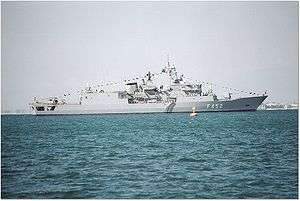Greek frigate Hydra
 Hydra (F-452) (Φ/Γ Ύδρα (F-452) | |
| History | |
|---|---|
| Name: | Hydra |
| Namesake: | the Hydra Island |
| Builder: | Blohm + Voss |
| Launched: | 25 June 1991 |
| Commissioned: | 1992 |
| Fate: | in active service |
| Notes: | Official Hellenic Navy page |
| General characteristics | |
| Class and type: | Hydra-class frigate |
| Displacement: | 3,350 tons |
| Length: | 117 m (384 ft) |
| Beam: | 14.8 m (49 ft) |
| Draught: | 6 m (20 ft) |
| Propulsion: |
|
| Speed: |
|
| Range: | 4,100 nmi (7,600 km; 4,700 mi) at 16 kn (30 km/h; 18 mph) (diesels) |
| Complement: | 173 |
| Sensors and processing systems: |
|
| Electronic warfare & decoys: | |
| Armament: |
|
| Aircraft carried: | 1 |
| Aviation facilities: | Hangar for 1 Sikorsky S-70B-6 Aegean Hawk helicopter |
Hydra (F-450) (Greek Φ/Γ Ύδρα) is the lead ship of the Greek Hydra-class frigate and flagship of the Hellenic Navy. The ship was built in the same shipyard as the Blohm + Voss MEKO 200 frigate class, on which its design was based. Three more vessels were built by Hellenic Shipyards Co. at Skaramagas in following years.[1] It is the fifth ship in the Hellenic Navy to bear the name Hydra.
Hydra was the first of four frigates of the MEKO 200 type (the four being Hydra, Spetsai, Psara, and Salamis) ordered by the Greek government. The ship was delivered to the Hellenic Navy on 15 October 1992 and first sailed in Greek waters on 28 January 1993. The crest of the frigate Hydra is the same as that of her predecessor. It is based on one of the flags which the ships of Hydra sailed under during the 1821 revolution.[2]
In April 1988, the Hellenic Navy proposed and approved the four frigates of the MEKO 200 type in an effort to modernize its fleet. After a lengthy negotiation process, the following contracts were signed to fulfill the program:
- A contract with ΜΕΚΟ Consortium (MC), Blohm + Voss AG and Thyssen Rheinstahl Technik to build the frigate in Germany.
- A second contract with MEKO Consortium to supply parts to Hellenic Shipyards to build the other three Hydra-class frigates in Scaramanga, Greece
History of the name
The ship's name comes from the island of Hydra, whose fleet participated in the war of national independence in 1811. Along with the fleets of the Greek islands of Spectate and Para, Hydra's fleet succeeded in taking control of the Aegean Sea and prevented the Ottoman Empire from successfully deploying its fleet.
- The first Hydra ship was a 26 gun sail corvette, which was purchased by the Greek Government and commissioned by the National Fleet on its first official formation in 1840. It was burnt in 1821 on Poros Island.
- The second was a 433-ton steam gunboat built at the Black Wall Shipyard in England in 1891. It was armed with one fixed Krupp 270/30 gun and one small rapid-fire gun.
- The third was a Greek ironclad with a displacement of 4,808 tons, built by the French company Forges et Chantiers de la Mediterranée at the St. Nazarene shipyard between 1887 and 1891. Following modifications and additions on her arm, this Hydra participated in naval operations in 1897 and 1912-13. She was retired in 1918 and anchored at Poros island where she was used as an ordnance school between 1922 and 1929, then finally scrapped.
- The fourth was one of four Dardo-class destroyers, with a full displacement of 1946 tons and a trial speed of 41.5 knots. The Dardo class Hydra was commissioned in 1942 and built by Odero-Terni-Orlando shipyard in La Spezia, Italy. She participated in naval operations during World War II and in the first surface raid in the Strait of Otranto (15 - 16 Nov. 1941). On April 22, 1942, she was sunk when attacked by dive bombers near the Loussess Islets in the Saronic Gulf. Many of her officers were killed during the attack.
References
- ↑ Vice Admiral C. Paizis-Paradellis, HN (2002). Hellenic Warships 1829-2001 (3rd Edition). Athens, Greece: The Society for the study of Greek History. p. 78. ISBN 960-8172-14-4.
- ↑ http://www.hellenicnavy.gr/index.php?option=com_content&view=article&id=4&Itemid=247&lang=en. Retrieved 26 January 2014. Missing or empty
|title=(help)